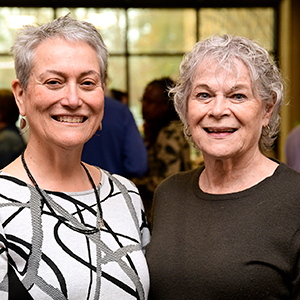NIEHS grantee Karletta Chief, Ph.D., from the University of Arizona, has been named director of the school’s new Indigenous Resilience Center. Chief and colleagues will collaborate with tribal leaders and governments to design community-driven solutions that address the adverse effects of environmental challenges among Indigenous groups.
 Among her other efforts, Chief studies environmental health risks and risk perceptions among Indigenous communities throughout the southwest U.S. (Photo courtesy of Karletta Chief)
Among her other efforts, Chief studies environmental health risks and risk perceptions among Indigenous communities throughout the southwest U.S. (Photo courtesy of Karletta Chief)On Oct. 25, Chief presented “Engaging Native American Communities in Environmental Health” as part of a webinar series hosted by the Puerto Rico Testsite for Exploring Contamination Threats Program. Her extensive outreach and educational efforts with Native American communities since the 2015 Gold King Mine Spill, which contaminated the Animas and San Juan rivers, was the focus of the talk.
Building on NIEHS collaboration
Chief noted that the new center was the logical next step from her multi-year Gold King Mine Spill Diné Exposure Project, which was supported through the NIEHS Superfund Research Program (SRP).
“We have been able to build on this effort in many ways,” she said. “There has been a lot of synergy. We have built trust in these communities, and we continue to build and strengthen community partnerships.”
A hydrologist whose research focuses on climate change impacts on water resources and Indigenous people, Chief has worked with tribes including Diné (Navajo), Pyramid Lake Paiute Tribe, Tohono O’odham Nation, Gila River Indian Community, the Indian Cooperative Extension, and the Inter Tribal Council of Arizona, among others.
Projects at the Indigenous Resilience Center will focus on agriculture, solar energy, off-grid water resources, food resources, and Native plant adaptation, among other topics. The center’s reach will stretch to additional tribes, Chief noted.
“It is critical that Native nations drive the research questions based on their priorities and long-standing local knowledge, and that the approaches involve decolonized and Indigenized approaches with Indigenous scientists leading these efforts,” she said.
Understanding historical trauma
After the 2015 Gold King Mine Spill, Chief, who is Diné, visited tribal communities monthly to host public forums and educational sessions. She integrated environmental health science and social science research methods to investigate the extent of environmental health exposure and the socioeconomic, cultural, and perceptual impacts that the mining spill had on tribal communities.
Perhaps more important, according to Chief, the team reported back to the communities to share research findings.
Breakthrough: Bitter Water
“It helps to understand the impacts of the spill within the context of historical trauma,” Chief explained. “It was our goal to develop a community-based model for emergency response that was based on their culture and values of harmony, restoration, and healing. In addition, the Navajo people already have a framework for problem solving, so we were mentored by community members, traditional leaders, and knowledge holders.”
She and tribal communities worked on educational programs and environmental crisis preparedness. SRP grants helped to fund environmental health modules and emergency response training courses with two tribal colleges, Tohono O’odham Community College and Diné College.
The translational research component of Chief’s fieldwork included the creation of environmental pictographs, fact sheets, and a standardized language translation glossary for the tribal communities affected by the Gold King Mine Spill.
Chief will continue working within these communities as director of the new Indigenous Resilience Center. The center will focus on Indigenous resilience through an interdisciplinary network of academic institutions.
(Jennifer Harker, Ph.D., is a technical writer-editor in the NIEHS Office of Communications and Public Liaison.)









